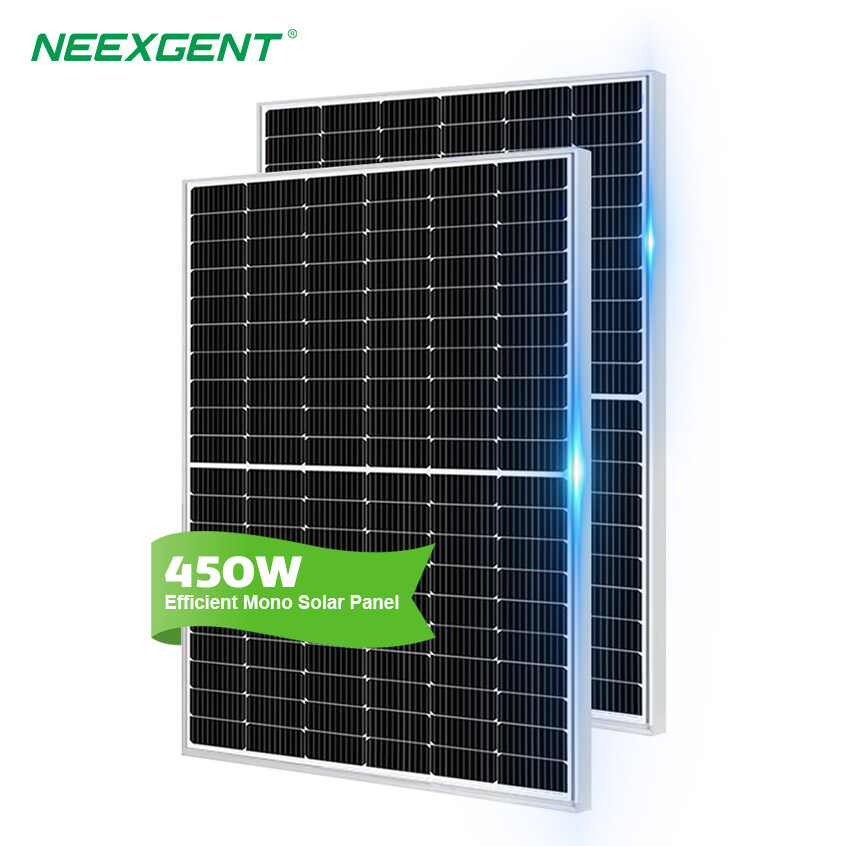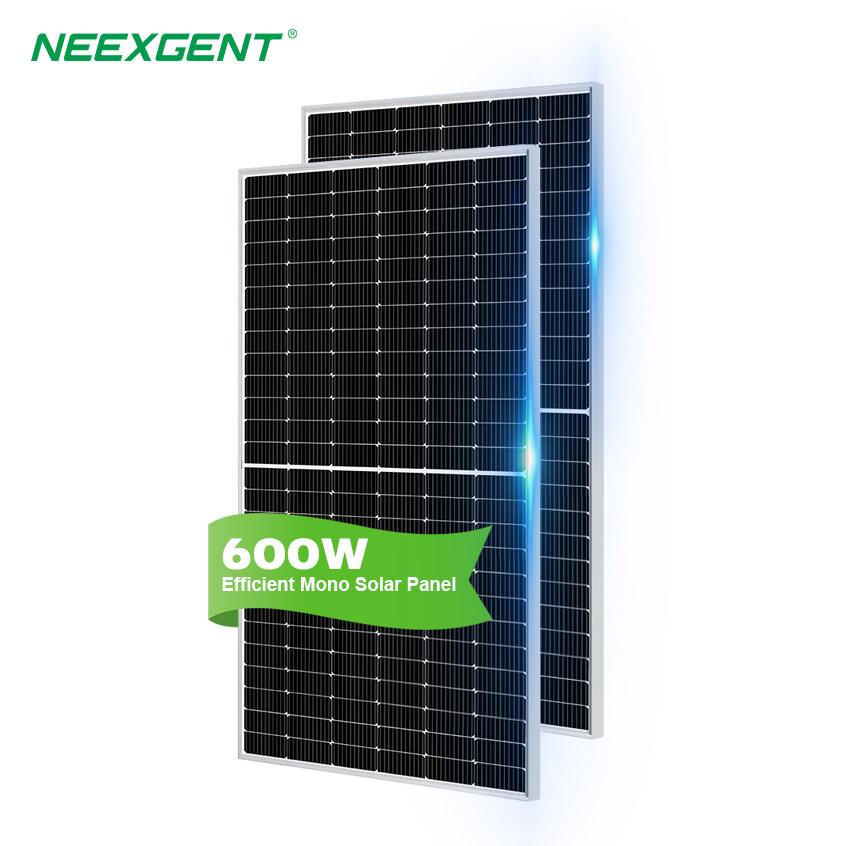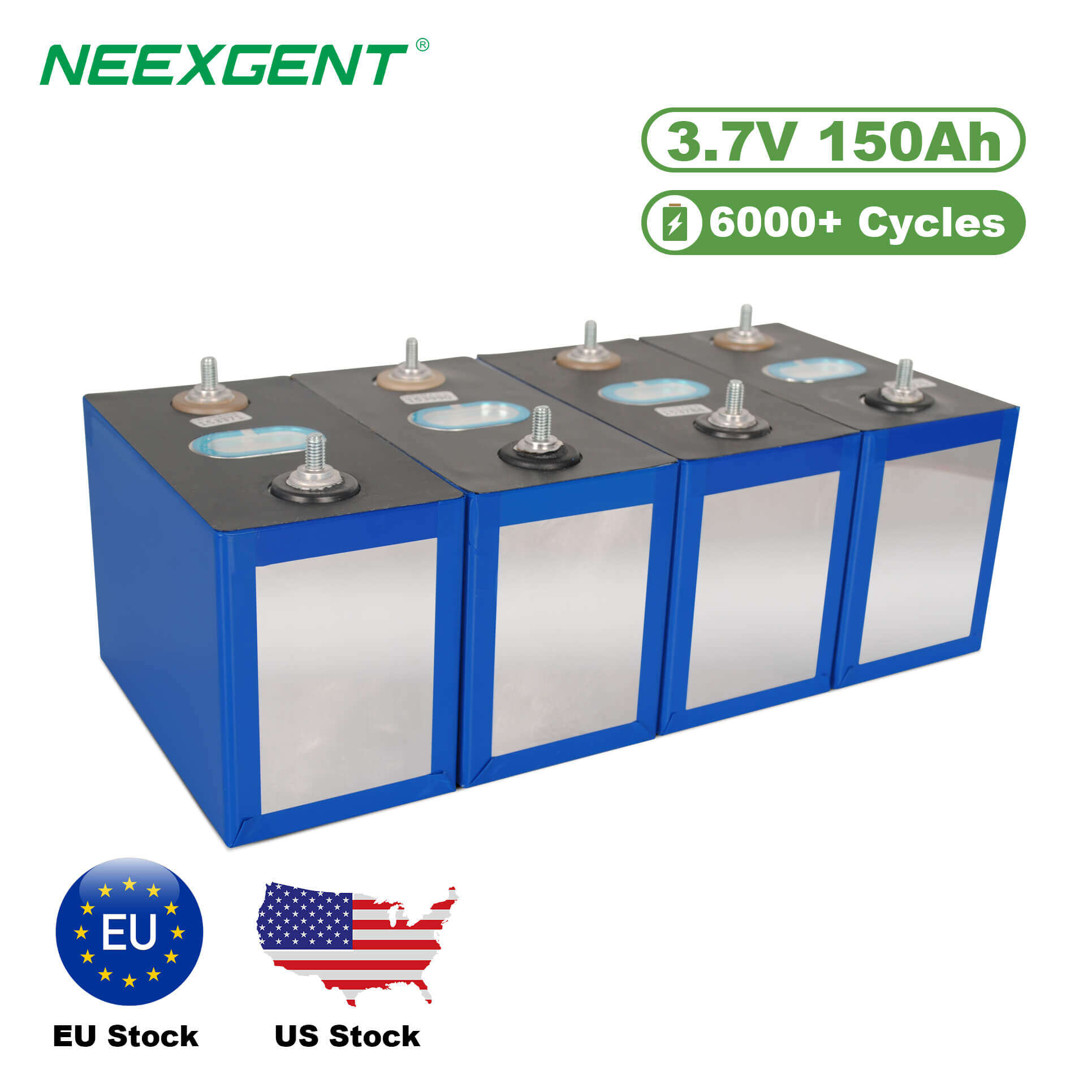Contents:
1. Contamination Challenges for Solar Panels in Sri Lanka
2. Key Technical Criteria for a Solar Panel Cleaning Brush in 2026
3. Leading Solar Panel Cleaning Brush Options for 2026
4. How to Select the Right Brush for Your Installation
5. Efficiency Improvement from Regular Cleaning
As Sri Lanka continues expanding its solar energy capacity across residential, commercial, and industrial sectors, long-term maintenance is becoming more important than ever. Solar panels naturally lose efficiency over time as dust, pollution, salt, and biological matter accumulate on their surfaces. Depending on location and season, unclean panels can experience a 10–30% drop in output.
A high-quality solar panel cleaning brush is one of the most effective and affordable solutions for restoring system performance. In 2026, Sri Lanka’s market includes several new-generation brushes designed for tropical climates. Among them, the NEEXGENT X41 solar panel cleaning brush stands out as one of the most advanced and versatile options for users in different environments.
1. Contamination Challenges for Solar Panels in Sri Lanka
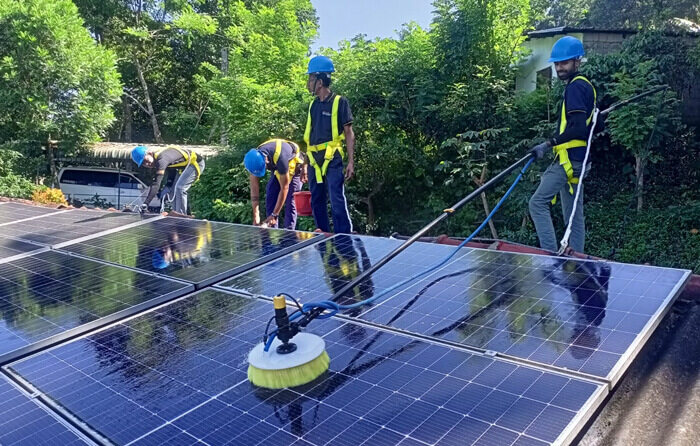
Sri Lanka’s climate and geography expose solar installations to various forms of soiling, each requiring different cleaning strengths.
1.1 Urban Areas: Dust and Soot
Urban centers like Colombo and Kandy are affected by fine particulate matter from traffic, construction sites, and general industrial activity. These particles settle evenly across PV glass, creating a haze that significantly affects efficiency, especially during dry months.
1.2 Coastal Zones: Salt Crystals and Sea Mist
Panels installed near coastlines face constant exposure to salt spray and humid winds. Salt crystals bond strongly with the glass surface and can attract more dust, creating an abrasive layer that must be cleaned with soft, non-scratching bristles.
1.3 Agricultural and Rural Regions
Rural areas generate soil dust, pollen, and frequent bird droppings. These contaminants not only shade the cells but can cause localized hotspots, which reduce long-term module lifespan.
1.4 Monsoon and Weather Impacts
Contrary to popular belief, heavy rainfall does not clean solar panels thoroughly. Instead, rain often redistributes dust, leaves mineral spots, and can even contribute to algae growth along panel edges.
| Region / Environment |
Dominant Contaminants |
Impact on Performance |
Cleaning Challenge |
| Urban rooftops |
Fine dust, soot, construction particles |
5–15% output loss |
Soft dense bristles needed to lift fine layers safely |
| Coastal zones |
Salt crystals, sea mist |
10–20% output loss |
Requires corrosion-resistant build and water-fed cleaning |
| Agricultural & rural regions |
Soil dust, pollen, bird droppings |
Hotspots and shading |
Must handle both dust films and hardened spots |
| Industrial areas |
Oil residue, soot films |
Up to 30% loss |
Needs wide coverage and consistent pressure |
2. Key Technical Criteria for a Solar Panel Cleaning Brush in 2026
To choose the best tool, solar owners must understand the technical requirements that ensure safe and effective cleaning.
2.1 Bristle Material
High-quality brushes use soft, split-tip synthetic bristles that can remove dirt without scratching the protective glass or anti-reflective coating. This is critical for maintaining panel longevity.
See also: The Role of Bristle Quality in Solar Panel Cleaning Brush
2.2 Cleaning Efficiency and Brush Width
A wider brush head increases coverage and reduces cleaning time. Dense bristle patterns lift dirt effectively instead of pushing it around.
2.3 Telescopic Pole and Ergonomics
Most Sri Lankan rooftops are tilted and difficult to stand on. Therefore, a professional brush must include a lightweight telescopic pole that allows reaching higher positions safely and comfortably.
2.4 Water-Fed Design
Water-fed systems help remove loosened debris and prevent streaking. They are especially useful in coastal and industrial zones where sticky contaminants are common.
2.5 Durability and Weather Resistance
UV exposure, high humidity, and salt environments require brushes built with corrosion-resistant materials and solid construction.
3. Leading Solar Panel Cleaning Brush Options for 2026
3.1 NEEXGENT X41 – Professional-Grade Solar Panel Brush
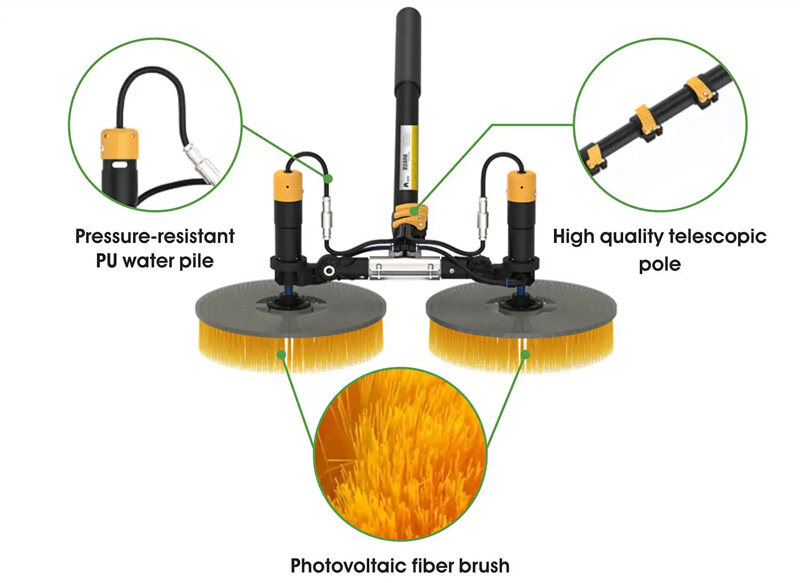
The NEEXGENT X41 is designed to meet the cleaning requirements of both residential and commercial solar installations. Its engineering prioritizes effective contaminant removal while maintaining the highest level of surface safety for modern PV modules.
Key advantages include:
-
Soft-density bristle structure with rounded tips to prevent micro-scratches
-
Water-fed cleaning head that improves rinsing efficiency and reduces streaking
-
Lightweight telescopic pole engineered for stable handling and extended reach
-
Anti-corrosion components ideal for coastal and high-humidity environments
-
Protective edge guards to minimize accidental frame or glass contact
The NEEXGENT X41 is well-suited for homeowners, commercial buildings, hotel facilities, agricultural installations, and utility-scale solar farms requiring reliable, regular maintenance.
3.2 Compact Residential Brush – Lightweight Manual Design
This category represents smaller, easy-to-handle brushes intended for home users with limited rooftop space. These brushes typically feature simple bristle structures, lower overall weight, and manual operation, making them suitable for light dust and pollen removal.
They offer a budget-friendly option for households where panels are easily accessible, though they may require more effort when dealing with stubborn buildup or salt-related deposits in coastal regions.
3.3 Commercial Heavy-Duty Brush – High-Coverage Cleaning Tool
Commercial-grade brushes are built with reinforced poles, wider brush heads, and higher durability for frequent use across larger solar arrays. They are often used by maintenance teams or facility operators who require rapid cleaning across multiple rows of panels.
While highly efficient for large-scale work, these brushes can be heavier and may cause user fatigue during extended cleaning sessions, making them more suitable for professional operators rather than residential users.
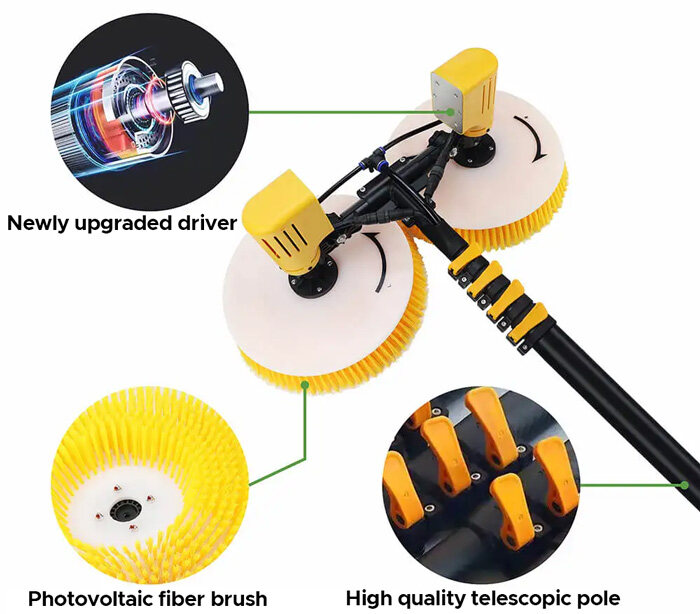
| Brand / Model |
Key Features |
Best Use Case |
Notes |
| NEEXGENT X42 |
Dual-head brush, 24V lithium battery pack, water-fed system, lightweight body |
Large commercial rooftops and medium to large solar arrays |
Designed for high-efficiency cleaning with extended operating time |
| XERO Solar Brush |
Hybrid nylon + boar hair bristles, optional water-fed attachment |
Residential and small commercial systems |
Lightweight and widely used for manual solar cleaning |
| Tucker Alpha Solar Brush |
Heavy-duty wide brush, water-fed jets, professional-grade pole system |
Commercial rooftops and medium-sized solar installations |
High build quality, suitable for regular and intensive cleaning |
| Unger nLITE Radius Brush |
Angled frame, dense bristles, jet ports for water flow |
Residential roofs and panels positioned at tight or angled locations |
Provides excellent edge and frame precision cleaning |
| SOLA-TECS C1000 |
Motorized/rotary cleaning head, high-pressure water-driven system |
Large ground-mounted solar farms |
One of the fastest cleaning solutions for utility-scale installations |
| QLEEN Classic Solar Brush |
Rotating water-fed brush, industrial-grade construction |
Industrial solar fields and large commercial installations |
Optimized for high-coverage, high-frequency cleaning operations |
4. How to Select the Right Brush for Your Installation
4.1 Based on Location
-
Urban: Soft bristles and a water-fed design are essential to remove fine pollution particles.
-
Coastal: Anti-corrosion components and regular cleaning cycles are critical.
-
Agricultural: Brushes must be capable of handling hardened bird droppings and soil deposits.
4.2 Based on Roof Height and Tilt
Steeper or higher rooftops require long telescopic poles to ensure cleaning can be done safely from stable positions.
4.3 Based on Cleaning Frequency
Systems cleaned monthly or bi-monthly benefit greatly from ergonomic, lightweight brushes like the X41, reducing strain during repeated cleaning tasks.
4.4 Cost vs Long-Term Output
Cheaper brushes may cause micro-scratches, permanently reducing efficiency. Investing in a high-quality brush improves long-term energy production and saves money over the system’s lifetime.
5. Efficiency Improvement from Regular Cleaning
Routine cleaning prevents gradual efficiency loss and helps solar panels maintain performance close to their designed output. A monthly cleaning schedule using a high-quality brush such as the NEEXGENT X41 can significantly stabilize production and reduce long-term energy loss.
The chart below illustrates a typical trend in relative system efficiency over 12 months after adopting a structured cleaning routine.

